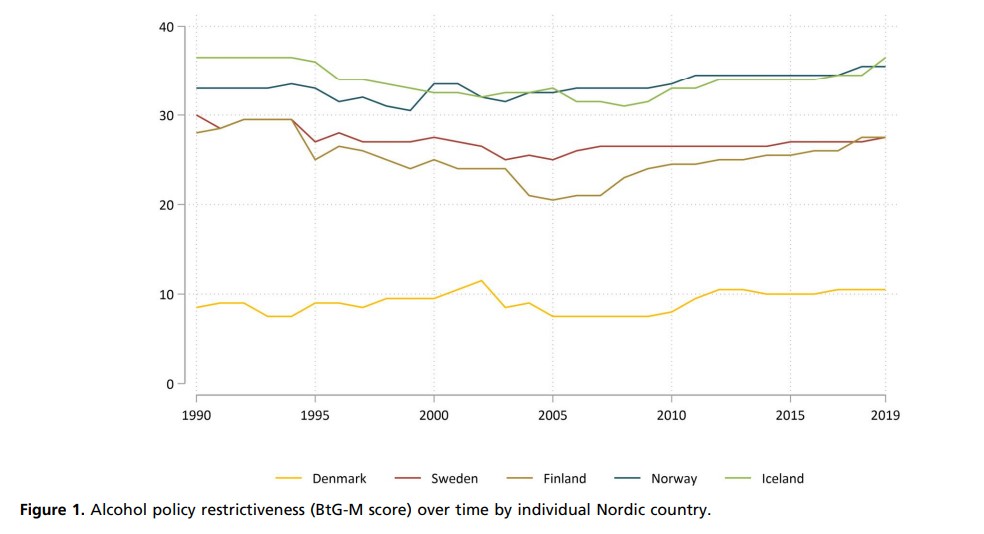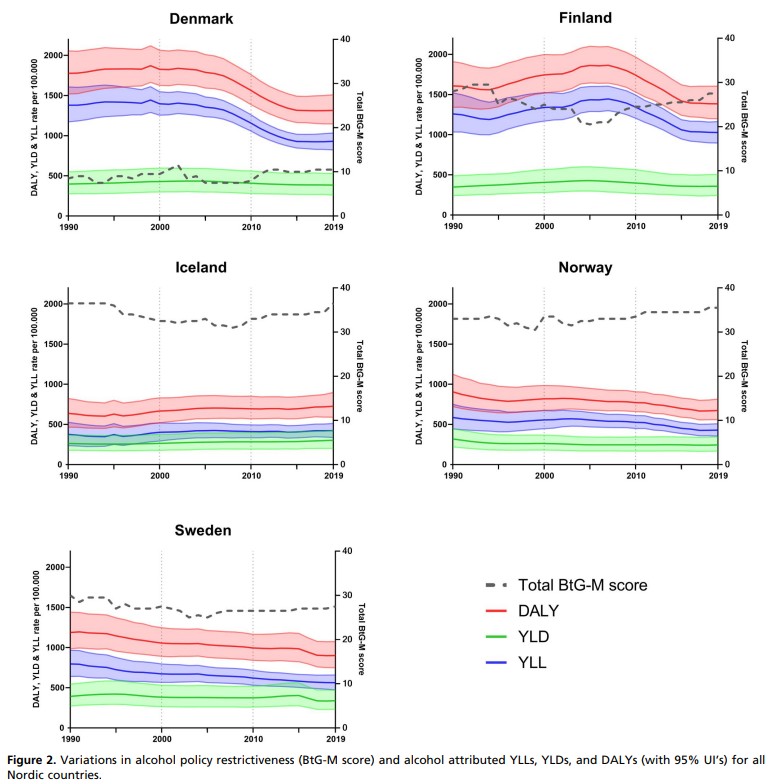Do strict alcohol policies really work?
-
Sist oppdatert
12. mai 2025
-
Kategori
A recent study shows how alcohol control measures have affected the rates of alcohol-related diseases in the Nordic countries over the past 30 years.
SCIENCE NEWS FROM KRISTIANIA: Public health
Key takeaways:
-
Stricter alcohol policies in Norway and Sweden reduced alcohol-related diseases, while Denmark’s lenient approach led to higher health risks.
-
Professor Adnan Kisa at Kristiania University of Applied Sciences found that enforcement strength and cultural norms shape policy effectiveness.
-
The study shows that alcohol policies impact both long-term diseases and immediate risks like traffic injuries and violence, demonstrating the need for strong, well-enforced regulations.
(The summary was created by AI and quality assured by the editors).
Stricter alcohol policies are linked to lower rates of alcohol-attributed diseases. However, our study shows that socio-cultural factors and the strength of enforcement significantly shape the effectiveness of these policies.
Governments in the Nordic countries employ several strategies: high excise taxes, monopolies to control availability, advertising restrictions, drunk driving limits, and age limits. Despite these efforts, cross-border alcohol trade, cultural drinking norms, and changing economic conditions continue to complicate policy effectiveness.
We investigated the effects of alcohol control measures on health outcomes in Denmark, Finland, Iceland, Norway, and Sweden over a 30-year period (1990–2019).
Norway and Iceland stood out with the most restrictive policies, while Denmark maintained minimal controls, resulting in more alcohol-related diseases.
Norway: Strict policies, significant health gains
Norway has one of the most comprehensive alcohol control frameworks in the Nordic region. Vinmonopolet govern when and where alcohol can be sold. Norway’s high distribution control dropped from 1996 due to changes in on-premise sales restrictions.
Key policies include:
- Excise taxes: Norway has among the highest alcohol taxes in the region
- Legal age limits: A minimum drinking age of 20 for spirits and 18 for beer and wine.
- Advertising ban: Since the 1990s, a strict national ban on alcohol advertising has been enforced.
- BAC (blood alcohol content) limit: Until 2000, Norway’s BAC limit for drivers was 0.05%. This was lowered to 0.02% in 2001.
These policies cut alcohol-related health burdens by over 20 per cent between 1990 and 2019, mainly by reducing chronic conditions like liver cirrhosis. Cross-border alcohol shopping remains a challenge.
Sweden: Balancing policy and control
Sweden controls availability through Systembolaget. Sweden’s complete ban on alcohol advertising was partially lifted in 2004.
Other key policies include:
- BAC limit: Sweden maintains a stringent 0.02% BAC limit.
- Moderate excise taxes: Taxation rates have fluctuated over time.
- Legal age limits: A minimum age of 20 for spirits and 18 for other alcoholic beverages.
Sweden has maintained a relatively high level of restrictiveness over these 30 years. Nevertheless, cultural drinking practices and cross-border trade pose challenges to the effectiveness of Sweden’s alcohol policies.

Read more:
Iceland: Tough restrictions, mixed results
Iceland enforces some of the strictest alcohol control measures through ÁTVR, its state-run alcohol and tobacco monopoly. The country has permanent restrictions on sales hours, days, and sales locations.
Key policies include:
- High Excise Taxes: Iceland’s alcohol taxation remains among the highest in the region.
- Marketing Restrictions: A full ban on alcohol advertising.
- BAC Limit: By 2019, Iceland reduced its BAC limit to 0.02%.
- Legal Age Limits: Iceland enforces a 20-year minimum drinking age for spirits and 18 for other beverages.
Despite these strict rules, alcohol-related health issues in Iceland rose by 14 per cent from 1990 to 2019. Researchers link this to changing economy and drinking habits.

Denmark: Minimal controls, high disease burden
Denmark adopts a lenient approach to alcohol control. The country lacks a state monopoly on alcohol production and distribution, and sales regulations are limited.
Key policies include:
- Gradual Introduction of Age Limits: Modest improvements followed the introduction of age limits for off-premise sales in 2012, requiring consumers to be at least 18 to purchase certain alcoholic beverages.
- Relaxed Marketing Rules: Advertising is governed by statutory control rather than a complete ban, limiting the impact of marketing restrictions on youth exposure.
- Higher BAC Limit: Denmark’s BAC limit of 0.05% is more lenient than in other Nordic countries, contributing to greater alcohol tolerance among drivers.
These policy weaknesses have contributed to Denmark’s high alcohol-attributed disease burden. Low enforcement and limited deterrent measures hinder efforts to control alcohol-related harm.
Finland: Policies in flux
Finland’s alcohol policies have fluctuated over time. Initially, strict state control defined Finland’s approach, but EU membership in the mid-1990s led to liberalization, replacing many off-premise sales restrictions with a licensing system and resulting in inconsistent excise taxes.
Key policies include:
- Loosened State Monopoly: Shifting to a licensing system weakened distribution control.
- Eased Marketing Restrictions: Finland transitioned from a full advertising ban to statutory control, reducing efforts to limit youth exposure to alcohol.
- Binge Drinking Culture: Strong social drinking traditions, including binge drinking, have counteracted policy effectiveness.
- Cross-Border Trade: Lower alcohol prices in neighboring countries have led to increased cross-border alcohol purchases, undermining local control efforts.
Despite these challenges, Finland maintains low BAC limits and prevention programs to mitigate alcohol-related risks. However, fluctuating policies and external factors have limited the success of these measures.

Health outcomes and policy challenges
From 1990 to 2019, alcohol-related health issues dropped in all Nordic countries except Iceland. Countries with stricter policies, such as Norway and Sweden, experienced over 20 per cent reductions in diseases such as liver cirrhosis, cardiovascular diseases, certain cancers, and alcohol-induced pancreatitis.
Immediate causes such as alcohol poisoning, traffic injuries, self-harm, and violence-related injuries showed mixed but notable improvements, particularly in younger male populations.
Men responded more to alcohol price hikes and restrictions. Women faced more mental health risks from alcohol, while men had higher dependence.
The reductions highlight the importance of comprehensive, well-enforced alcohol policies that address both delayed and immediate health risks. Future public health campaigns aimed at raising awareness of alcohol's harmful effects—especially those targeting younger at-risk groups—could complement these regulatory measures to further sustain and enhance the gains in reducing alcohol-related harm.
About the study:
The scale evaluates key criteria, including government control over alcohol production and distribution, legal drinking age limits, marketing restrictions, social measures such as blood alcohol concentration (BAC) limits, and excise taxes. A maximum score of 40 on the BtG scale signifies the highest level of policy restrictiveness.
The study estimated how much disease is caused by alcohol using a comparative risk assessment method. It followed three main steps:
1. Assessing Health Risks – Researchers reviewed past studies to estimate how different alcohol levels increase the risk of 23 diseases.
2. Measuring Alcohol Use – They collected data from sales records, surveys, and global health databases to estimate alcohol consumption, including unrecorded and tourist drinking.
3. Calculating Disease Burden – They combined alcohol consumption data with disease risks to estimate how much illness and early death was due to alcohol use.
This approach helps understand the health impact of alcohol in a population.
References:
GBD 2019 Diseases and Injuries Collaborators (2020) Global burden of 369 diseases and injuries in 204 countries and territories, 1990-2019: a systematic analysis for the Global Burden of Disease Study 2019. The Lancet, 396(10258), pp. 1204-1222.
van der Velde, L., Shabaan, A. N., Månsson, A., Wennberg, P., Allebeck, P., Karlsson, T. G., Flodin, P., Eikemo, T. A., Skrindo Knudsen, A. K., de Soysa, I., Skogen, J. C; GBD 2019 Nordic Alcohol Collaborators; Gissler, M., McGrath, J. J., Sigfusdottir, I. D., Sigurvinsdottir, R., Pasovic, M., Danielsson, A.K., Agardh, E.E. (2024) Alcohol-attributed disease burden and formal alcohol policies in the Nordic countries (1990-2019): an analysis using the Global Burden of Disease Study 2019. European Journal of Public Health, 35(1), pp. 52-59.
Text: Adnan Kisa, professor at the School of Health Sciences, Kristiania University of Applied Sciences.
This text was first published on sciencenorway.no on the 20th of February 2025 with the title "Do strict alcohol policies really work?".
We love hearing from you!
Send your comments and questions regarding this article by e-mail to kunnskap@kristiania.no.
Siste nytt fra Kunnskap Kristiania
 Kunnskap KristianiaLes mer
Kunnskap KristianiaLes merHva er god utdanning?
I Kunnskap Kristianias nye temautgave har vi invitert forskere og undervisere til å reflektere rundt hvordan vi lærer, og hvordan god utdanning formes. Kunnskap KristianiaLes mer
Kunnskap KristianiaLes merFred for enhver pris?
Kjære Nobelkomité: Det finnes tider da dere ikke bare deler ut en pris, men skriver i verdens moralske grunnbok. Kunnskap KristianiaLes mer
Kunnskap KristianiaLes merShort exchange programmes provide meaningful learning experiences
By participating in an exchange programme, students develop skills such as critical thinking, empathy and intercultural understanding. Kunnskap KristianiaLes mer
Kunnskap KristianiaLes merBlack Friday: kjøpefest eller klimaskam?
Adventstiden handler ikke bare om lys og forventning. Den handler like mye om handelens egen høytidsdag.







